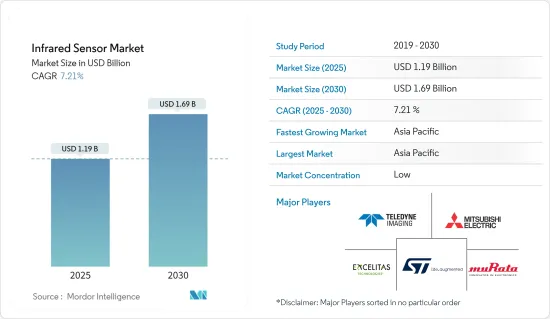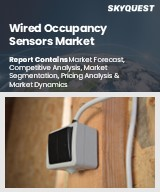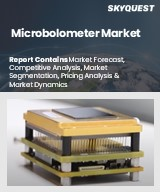
|
시장보고서
상품코드
1641971
적외선 센서 : 시장 점유율 분석, 산업 동향 및 통계, 성장 예측(2025-2030년)Infrared Sensor - Market Share Analysis, Industry Trends & Statistics, Growth Forecasts (2025 - 2030) |
||||||
적외선 센서 시장 규모는 2025년에 11억 9,000만 달러로 추정되며, 예측 기간(2025-2030년) 동안 연평균 7.21%로 2030년까지 16억 9천만 달러에 달할 것으로 예상됩니다.

적외선(IR) 센서는 780nm에서 50μm까지의 스펙트럼 감도를 가지며 환경과의 상호작용을 변화시켜 다양한 산업에서 필수적입니다. 적외선을 감지함으로써 이러한 센서는 명확한 이점을 제공하여 광범위한 채택으로 이어집니다. 적외선 센서는 조명 및 경보 시스템을 작동시키기 위해 빌딩 서비스에서 일반적으로 채택되는 모션 감지기에서 중요한 역할을 합니다. 이 센서는 특정 각도 범위 내에서 물체와 개인의 움직임으로 인한 열 복사의 시간적 및 공간적 변화를 감지합니다.
주요 하이라이트
- 시장은 소비자 스마트 기기 수요 급증에 힘입어 확대되고 있습니다. 자동차 부문도 성장하고 있으며 특히 ADAS 및 충돌 감지와 같은 고급 안전성과 편리성에 대한 요구가 커지고 있습니다. 의료 부문에서는 적외선 센서에 대한 의존도가 높아지고 있으며 위협 감지를 강화하기 위해 항공우주 및 방위 부문에서의 채택이 진행되고 있는 것도 시장 확대를 더욱 강화하고 있습니다.
- 예를 들어, 스마트 홈 디바이스 수요가 급증하고 있습니다. Consumer Technology Association(CTA)의 예측에서 미국 스마트 홈 디바이스 매출은 2023년에 235억 달러에 이릅니다. IR 기반 모션 센서는 스마트 조명 시스템, 모니터링 시스템 및 자동 도어록에서 중요한 역할을 하며 보안과 에너지 효율을 모두 향상시킵니다. 이러한 동향은 향후 몇 년 동안 채택을 촉진할 것으로 예상됩니다.
- 의료 산업에서는 환자 모니터링 및 의료용 화상 처리 등 다양한 용도로 IR 센서의 채용이 진행되고 있습니다. IR 센서에 의한 비접촉 온도 측정의 중요성은 세계의 건강 위기 때 강조되고 있으며, 이 동향은 COVID-19 팬데믹 후에도 계속될 것으로 예상됩니다. IR 센서의 비접촉 기능이 2차 오염의 위험을 완화한다는 점을 감안할 때 의료 환경에서의 가치는 부인할 수 없습니다. 이 동향은 향후 몇 년동안 지속적인 성장의 무대가 될 것입니다.
- IR 센서의 기술적 한계는 조사 대상 시장의 성장에 큰 과제가 되고 있습니다. 예를 들어, 적외선 주파수는 벽이나 문과 같은 고형물, 먼지, 연무, 태양광의 영향을 받을 수 있습니다. 스크린 및 제어 용도에서 IR 센서는 한 번에 하나의 장치만 관리할 수 있으므로 직접 시선 밖에 있는 것을 제어하기가 어렵습니다.
- 세계 공급망은 이미 운송 비용 상승, 인플레이션 지속, 노동력 부족 지속, 필수품 부족, 수요 변동 등 수많은 과제를 다루고 있습니다. 불경기는 이러한 문제를 더욱 악화시키는 것으로 예상됩니다. 잠재적인 경기침체의 정확한 시기와 강도를 파악하는 것은 여전히 어렵지만, 기업은 이러한 영향에 대해 통찰함으로써 공급망에 미치는 영향에 더 잘 대처할 수 있습니다. 그럼에도 불구하고 예측 기간은 낙관적으로 보이며, 대부분의 경제와 산업 부문이 다시 탄력을 받을 것으로 예상되어 해당 시장에 기회를 제공할 것입니다.
적외선(IR) 센서 시장 동향
자동차산업이 최종사용자로 급성장
- 기술의 진보로 자동차 시장 경쟁이 치열해지고 있는 가운데 소비자는 안전성과 신뢰성 향상, 전체적으로 뛰어난 운전 체험을 약속하는 자동차를 우선하는 경향이 강해지고 있습니다. 이러한 소비자의 관심이 높아짐에 따라 자율주행차의 개발에 박차를 가해 자동차 부문에 있어서의 전자 디바이스 수요를 촉진하고 있습니다. 과제는 센싱, 프로세싱, 시작, 피드백 및 제어 기능에서 인간의 두뇌의 능력을 전자 제품으로 대체하는 것이며, 이는 매우 흥미롭고도 어려운 작업입니다.
- 1905년부터 자동차 규격을 정하고 있는 미국의 기술자 단체인 자동차 기술회(SAE)는 자동차의 자율성을 6단계로 분류하고 있습니다. 미국 에너지 정보국에 따르면 레벨 5의 자율성은 완전한 자동화를 의미하며 차량이 모든 조건 하에서 모든 운전 기능을 효율적으로 수행할 수 있음을 의미합니다. 여기에는 악천후나 야간 상황에서의 자율운전도 포함됩니다. 이러한 시나리오가 자주 자동차 사고로 이어질 수 있다는 점에서 이러한 효과적인 인식은 매우 중요합니다.
- FIR의 우수성은 다양한 조명 조건 하에서 일관된 이미지를 생성하는 데에도 도움이 됩니다. 일반 CMOS 이미지와 달리 물체의 색상, 배경, 조명 방향, 여러 광원, 경면 반사 및 기타 조명으로 인해 비정상적인 영향을 받을 수 있습니다. FIR 이미지는 불변입니다.
- 예를 들어, CMOS 카메라는 차선이나 도로 표시를 능숙하게 감지하지만, 시각적 불일치가 크므로, 백낮에서도 주행 가능한 도로 영역을 핀 포인트로 검출하지 못하는 경우가 많습니다. 대조적으로, FIR 이미지는 다양한 조명 시나리오에 걸쳐 일관된 도로 외관을 유지합니다. 이 일관성은 자율주행차에 있어서 가장 중요하며, 자율주행차는 살아있는 것에도 살지 않는 것에도 대응하기 위해 필요한 명료함으로 환경을 인식할 수 있습니다.
- 세계 시장에서는 플러그 전기자동차(PEV) 수요가 급증하고 있습니다. 국제에너지기구(IEA)에 따르면 2023년에는 약 1,370만대의 플러그인 전기자동차(PEV)가 판매된다고 합니다. 전기자동차의 인기가 급상승하고 있는 것은 시장의 매력을 강조하고, 그 유망한 성장 전망을 돋보이게 합니다. 첨단 열전대와 적외선 센서는 전체 인버터 파워 일렉트로닉스의 온도 구배를 측정하고, 열 평형을 보장하고, EV 모터의 수명을 연장하는 데 있어 매우 중요한 역할을 합니다.
큰 성장을 기록하는 아시아태평양
- 아시아태평양에는 일본, 한국, 중국 및 대만 기업을 포함한 세계 최대의 소비자용 전자 기기 제조업체가 있습니다. 적외선 센서 수요 증가는 얼굴 인식, 근접 감지, 원격 조작 등의 용도로 스마트폰, 태블릿, 기타 스마트 장치에 사용되는 것이 원동력이 되고 있습니다.
- 이 지역의 적외선 센서(IR 센서) 수요는 자동차,운수, 재생 가능 에너지, 적외선 센서(IR)를 많이 사용하는 기타 산업 등 다양한 부문의 진보에 의해 높아지고 있습니다. 예를 들어, 가장 유명한 자동차 생산국인 중국의 대규모 자동차 제조 규모는 IR 센서의 높은 수요에 기여하고 있습니다. 수백만 대의 자동차에 첨단 센싱 기술을 탑재할 필요가 있기 때문에 IR 센서 시장이 확대되고 있습니다.
- 중국의 신에너지 자동차 산업 개발 계획(2021-2035년)에 따르면 전기자동차는 2025년까지 25% 시장 점유율을 획득할 수 있습니다. 따라서 중국은 전기자동차의 보급을 촉진하기 위해 보다 적극적인 시책을 실시하고 있으며, 그 결과 전기자동차에서 폭넓게 이용되는 이산 반도체의 채용이 가속화되고 있습니다.
- 2023년 8월, CAAM은 중국이 58만 9,000대의 배터리 전기자동차(BEV)를 제조했다고 보고했습니다. 그 내역은 승용차용 BEV가 55만 1,000대, 상용 BEV(배터리 전기자동차)가 3만 8,000대였습니다. 게다가 같은 달 중국에서는 25만 4,000대의 플러그인 하이브리드차(PHEV)가 생산되어 그 중 25만 3,000대가 승용 PHEV, 1,000대가 상용 PHEV였습니다.
- 2024년 6월 GalaxEye Space는 국방부 산하의 이니셔티브인 iDEX DIO와 제휴하여 새로운 멀티 센서 융합 처리 시스템을 구축했습니다. 이 시스템은 특히 인도 공군(IAF)을 위해 최대 150kg의 여러 페이로드를 갖춘 소형 위성을 위해 설계되었습니다. 이 첨단 시스템은 먼저 적외선 센서의 데이터를 처리하여 지상국으로 중계합니다.
적외선(IR) 센서 산업 개요
적외선 센서 시장은 부문화되어 경쟁이 심합니다. 치열한 경쟁을 유지하기 위해 지역 기업은 주요 성장 전략으로 고비용 연구 개발, 파트너십, 제휴 및 인수를 채택하고 있습니다. 이 시장의 주요 기업으로는 Murata Manufacturing, STMicroelectronics NV, Excelitas Technologies, Teledyne Imaging Inc., Mitsubishi Electric Corporation 등이 있습니다.
- 2024년 4월: InfraTec GmbH는 2년 반이라는 단기간에 실현된 신사옥의 완성을 발표했습니다. 신사옥이 가동한 것으로, 동사는 기존 시설의 개수에 착수했습니다. 2,700 평방미터의 광대 한 사이트는 최첨단 열화상 카메라 및 적외선 검출기의 생산 및 개발에 사용됩니다.
- 2023년 11월 Hydrosat과 Muon Space는 전략적 파트너십을 체결하여 Hydrosat의 CaaS(Constellation-as-a-Service) 우주선 계약 체결에 이르렀습니다. Hydrosat의 최첨단 멀티스펙트럼과 열적외선(IR) 이미징 장비를 탑재할 것으로 기대되는 이 협업은 저궤도(LEO)에 소형 위성의 별자리를 전개하는 Hydrosat의 비전을 크게 발전시키고 있습니다. 이러한 위성은 기후 변화로 인해 민물 부족이 심각해짐에 따라 농업에서 물 이용 효율을 높이는 중요한 데이터를 제공하는 것을 목표로 합니다.
기타 혜택
- 엑셀 형식 시장 예측(ME) 시트
- 3개월간의 애널리스트 서포트
목차
제1장 서론
- 조사의 전제조건과 시장 정의
- 조사 범위
제2장 조사 방법
제3장 주요 요약
제4장 시장 인사이트
- 시장 개요
- 산업의 매력 - Porter's Five Forces 분석
- 공급기업의 협상력
- 구매자의 협상력
- 신규 참가업체의 위협
- 대체품의 위협
- 경쟁 기업간 경쟁 관계의 강도
- 거시 경제 동향이 시장에 미치는 영향
제5장 시장 역학
- 시장 성장 촉진요인
- 산업 셋업에 있어서의 무선 기술과 자동화 기술의 채용 증가
- 홈 오토메이션 제품과 스마트 디바이스 수요 증가
- 시장의 과제
- 기술적 한계와 제조의 복잡화
제6장 시장 세분화
- 유형별
- 근적외선(NIR)
- 적외선
- 원적외선(FIR)
- 최종 사용자 산업별
- 의료
- 항공우주 및 방위
- 자동차
- 상업용도
- 제조업
- 석유 및 가스
- 기타
- 지역별
- 북미
- 유럽
- 아시아
- 호주 및 뉴질랜드
- 라틴아메리카
- 중동 및 아프리카
제7장 경쟁 구도
- 기업 프로파일
- Murata Manufacturing Co. Ltd
- STMicroelectronics NV
- Excelitas Technologies
- Teledyne Imaging Inc.
- Mitsubishi Electric Corporation
- Amphenol Advanced Sensors(Amphenol Corporation)
- SENBA Sensing Technology Co. Ltd
- Nippon Ceramic Co. Ltd
- Panasonic Corporation
- Broadcom Inc.
- Melexis NV
- Hamamatsu Photonics kk
- InfraTec GmbH
제8장 투자 분석
제9장 시장의 미래
SHW 25.02.19The Infrared Sensor Market size is estimated at USD 1.19 billion in 2025, and is expected to reach USD 1.69 billion by 2030, at a CAGR of 7.21% during the forecast period (2025-2030).

Infrared or IR sensors, with a spectral sensitivity ranging from 780 nm to 50 µm, have become indispensable across diverse industries, transforming interactions with the environment. By detecting infrared radiation, these sensors provide distinct advantages, leading to their broad adoption. IR sensors play a pivotal role in motion detectors, commonly employed in building services to activate lamps or alarm systems. Within a specified angular range, these sensors detect temporal and spatial changes in heat radiation attributed to the movement of objects or individuals.
Key Highlights
- The market is expanding, fueled by the surging demand for smart consumer devices. The automotive sector is also growing, particularly with the rising need for advanced safety and convenience features like ADAS and collision detection. The healthcare sector's increasing reliance on IR sensors, along with their adoption in aerospace and defense for enhanced threat detection, further propels the market's expansion.
- For instance, the demand for smart home devices has surged. Estimates from the Consumer Technology Association (CTA) projected that revenue from smart home devices in the United States would hit USD 23.5 billion in 2023. Given that IR-based motion sensors play a pivotal role in smart lighting systems, surveillance systems, and automated door locks, boosting both security and energy efficiency. These trends are set to propel their adoption in the coming years.
- The healthcare industry is increasingly adopting IR sensors for diverse applications, including patient monitoring and medical imaging. The significance of non-contact temperature measurement via IR sensors has been underscored during global health crises, and this trend is expected to persist even after the COVID-19 pandemic. Given that the contactless functionality of IR sensors mitigates the risk of cross-contamination, their value in healthcare settings is undeniable. This trend sets the stage for continued growth in the coming years.
- Nonetheless, the technical limitations of IR sensors pose significant challenges to the growth of the market studied. For example, infrared frequencies can be affected by solid objects like walls and doors, as well as by dust, haze, and sunlight. In screen and control applications, IR sensors can only manage one device at a time, making it challenging to control items outside their direct line of sight.
- Global supply chains are already grappling with numerous challenges, such as soaring transportation costs, persistent inflation, ongoing labor shortages, a shortage of essential goods, and fluctuating demand. A recession would only exacerbate these issues. While pinpointing the exact timing and intensity of a potential recession remains elusive, organizations can better prepare for its ramifications on supply chains by gaining insights into these impacts. Nevertheless, the forecast period looks optimistic, with most economies and industrial sectors expected to regain momentum, presenting opportunities in the market studied.
Infrared (IR) Sensor Market Trends
Automotive Industry to be the Fastest Growing End User
- As competition within the automotive market intensifies due to technological advancements, consumers increasingly prioritize vehicles that promise enhanced safety, reliability, and an overall superior driving experience. This heightened consumer interest has spurred the development of autonomous vehicles, propelling the demand for electronic devices within the automotive sector. The challenge lies in replacing the capabilities of the human brain in sensing, processing, activation, feedback, and control functions with electronics, which is an exhilarating and daunting task.
- The Society of Automotive Engineers (SAE), an American engineering group setting automotive standards since 1905, outlines six levels of vehicle autonomy. According to the US Energy Information Administration, Level 5 autonomy signifies full automation, which means a vehicle can efficiently perform all driving functions under all conditions." This encompasses operating autonomously in adverse weather and nighttime conditions. Such effective perception is vital, given these scenarios frequently lead to vehicular accidents.
- FIR's prowess extends to producing consistent images under varying lighting conditions. Unlike regular CMOS images, which can be influenced by an object's color, background, illumination direction, multiple light sources, specular reflections, and other lighting-induced anomalies. FIR images remain steadfast.
- For example, while CMOS cameras adeptly detect lanes and road markings, they often falter in pinpointing the drivable road area even in broad daylight due to significant visual discrepancies. In contrast, FIR images maintain a consistent visual road appearance across diverse lighting scenarios. This consistency is paramount for autonomous vehicles, ensuring they perceive their environment with the clarity needed to respond to both living and non-living entities.
- The global market is witnessing a surging demand for plug-electric vehicles (PEVs). According to the International Energy Agency (IEA), approximately 13.7 million plug-in electric light vehicle (PEV) units were sold in 2023. Electric vehicles' burgeoning popularity underscores their market appeal and highlights their promising growth prospects. This is particularly evident as advanced thermocouples and infrared sensors play a pivotal role in measuring temperature gradients across inverter power electronics, ensuring thermal equilibrium and prolonging EV motors' lifespan.
Asia-Pacific to Register Major Growth
- The Asia-Pacific region is home to some of the largest consumer electronics manufacturers globally, including companies in Japan, South Korea, China, and Taiwan. The rising demand for IR sensors is driven by their use in smartphones, tablets, and other smart devices for applications like facial recognition, proximity sensing, and remote.
- The demand for infrared sensors (IR sensors) in the region is rising owing to advancements in various sectors such as automotive & transportation, renewable energy, and other industries that utilize Infrared sensors (IR) extensively. For instance, as the most prominent automotive producer, China's massive vehicle manufacturing scale contributes to the high demand for IR sensors. The need to equip millions of vehicles with advanced sensing technologies creates a substantial market for IR sensors.
- According to China's Development Plan for the New Energy Automobile Industry (2021-2035), electric vehicles could capture a 25% market share by 2025. Consequently, China is implementing more assertive measures to incentivize the adoption of electric vehicles, thereby expediting the adoption of discrete semiconductors for their extensive utilization in EVs.
- In August 2023, CAAM reported that China manufactured 589,000 battery electric vehicles (BEVs), comprising 551,000 passenger BEVs and 38,000 commercial BEVs (battery electric vehicles). Additionally, 254,000 plug-in hybrid electric vehicles (PHEVs) were produced in China during the same month, with 253,000 being passenger PHEVs and 1,000 being commercial PHEVs.
- In June 2024, GalaxEye Space partnered with iDEX DIO, an initiative under the Ministry of Defence, to create a new multi-sensor fusion processing system. This system is designed for compact satellites that accommodate multiple payloads weighing up to 150kg, specifically for the Indian Air Force (IAF). The advanced system will first process data from infrared sensors and then relay it to ground stations.
Infrared (IR) Sensor Industry Overview
The infrared sensor market is fragmented and highly competitive. To sustain intense competition, regional companies adopt high-cost research and development, partnerships, collaborations, and acquisitions as their prime growth strategies. Key players in the market are Murata Manufacturing Co. Ltd, STMicroelectronics NV, Excelitas Technologies, Teledyne Imaging Inc., Mitsubishi Electric Corporation, and many more.
- April 2024: InfraTec GmbH proudly announced the completion of its new extension building, a project realized in a swift two and a half years. With the new structure now operational, the company has turned its attention to renovating the existing facility. The enhancements boast a vast 2,700 m2 area dedicated to the production and development of cutting-edge thermography cameras and infrared detectors.
- November 2023: Hydrosat and Muon Space entered into a strategic partnership, culminating in a contract for Hydrosat's debut Constellation-as-a-Service (CaaS) spacecraft. Anticipated to be equipped with Hydrosat's state-of-the-art multispectral and thermal infrared (IR) imaging instruments, this collaboration significantly advances Hydrosat's vision of deploying a constellation of small satellites in Low Earth Orbit (LEO). These satellites aim to provide crucial data, enhancing water use efficiency in agriculture, a pressing need given the rising freshwater scarcity exacerbated by climate change.
Additional Benefits:
- The market estimate (ME) sheet in Excel format
- 3 months of analyst support
TABLE OF CONTENTS
1 INTRODUCTION
- 1.1 Study Assumptions and Market Definition
- 1.2 Scope of the Study
2 RESEARCH METHODOLOGY
3 EXECUTIVE SUMMARY
4 MARKET INSIGHTS
- 4.1 Market Overview
- 4.2 Industry Attractiveness - Porter's Five Forces Analysis
- 4.2.1 Bargaining Power of Suppliers
- 4.2.2 Bargaining Power of Buyers
- 4.2.3 Threat of New Entrants
- 4.2.4 Threat of Substitute Products
- 4.2.5 Intensity of Competitive Rivalry
- 4.3 Impact of Macroeconomic Trends on the Market
5 MARKET DYNAMICS
- 5.1 Market Drivers
- 5.1.1 Rising Adoption of Wireless and Automated Technologies in Industrial Setups
- 5.1.2 Growing Demand for Home Automation Products and Smart Devices
- 5.2 Market Challenges
- 5.2.1 Technological Limitations and Increasing Manufacturing Complexity
6 MARKET SEGMENTATION
- 6.1 By Type
- 6.1.1 Near Infrared (NIR)
- 6.1.2 Infrared
- 6.1.3 Far Infrared (FIR)
- 6.2 By End-user Industry
- 6.2.1 Healthcare
- 6.2.2 Aerospace and Defense
- 6.2.3 Automotive
- 6.2.4 Commercial Applications
- 6.2.5 Manufacturing
- 6.2.6 Oil and Gas
- 6.2.7 Other End-user Industries
- 6.3 By Geography
- 6.3.1 North America
- 6.3.2 Europe
- 6.3.3 Asia
- 6.3.4 Australia and New Zealand
- 6.3.5 Latin America
- 6.3.6 Middle East and Africa
7 COMPETITIVE LANDSCAPE
- 7.1 Company Profiles
- 7.1.1 Murata Manufacturing Co. Ltd
- 7.1.2 STMicroelectronics NV
- 7.1.3 Excelitas Technologies
- 7.1.4 Teledyne Imaging Inc.
- 7.1.5 Mitsubishi Electric Corporation
- 7.1.6 Amphenol Advanced Sensors (Amphenol Corporation)
- 7.1.7 SENBA Sensing Technology Co. Ltd
- 7.1.8 Nippon Ceramic Co. Ltd
- 7.1.9 Panasonic Corporation
- 7.1.10 Broadcom Inc.
- 7.1.11 Melexis NV
- 7.1.12 Hamamatsu Photonics kk
- 7.1.13 InfraTec GmbH



















